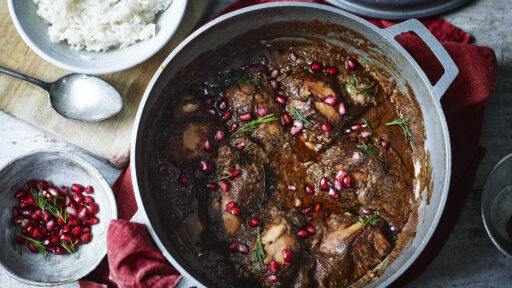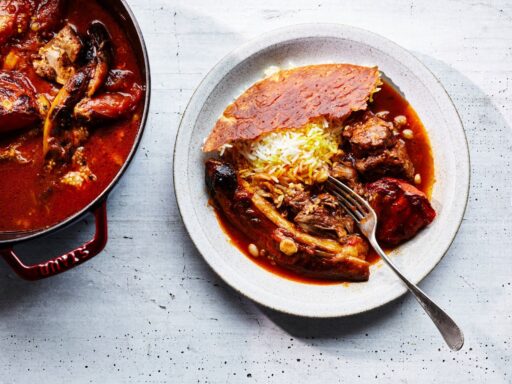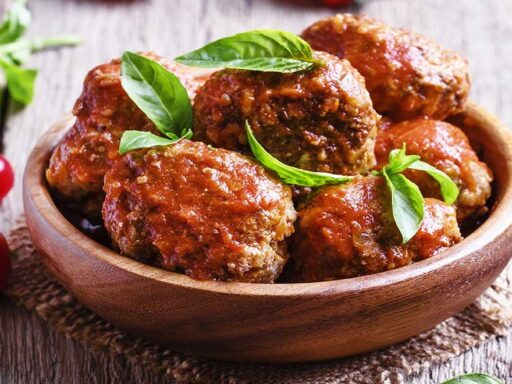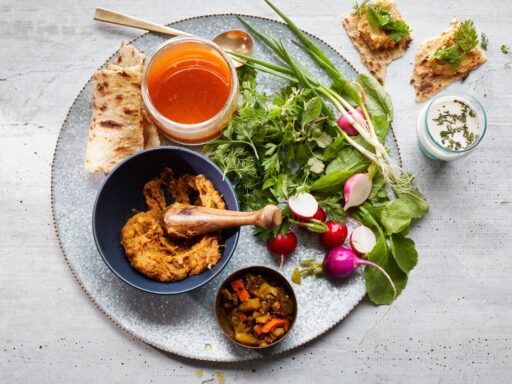Iranian cuisine is known for its rich and complex flavors, combining unique ingredients and spices to create memorable dishes. Among these, Khoresh-e Fesenjan stands out as a particularly beloved and iconic stew. This article will explore the origins, ingredients, preparation methods, and cultural significance of Khoresh-e Fesenjan, providing a comprehensive guide to this quintessential Iranian dish.
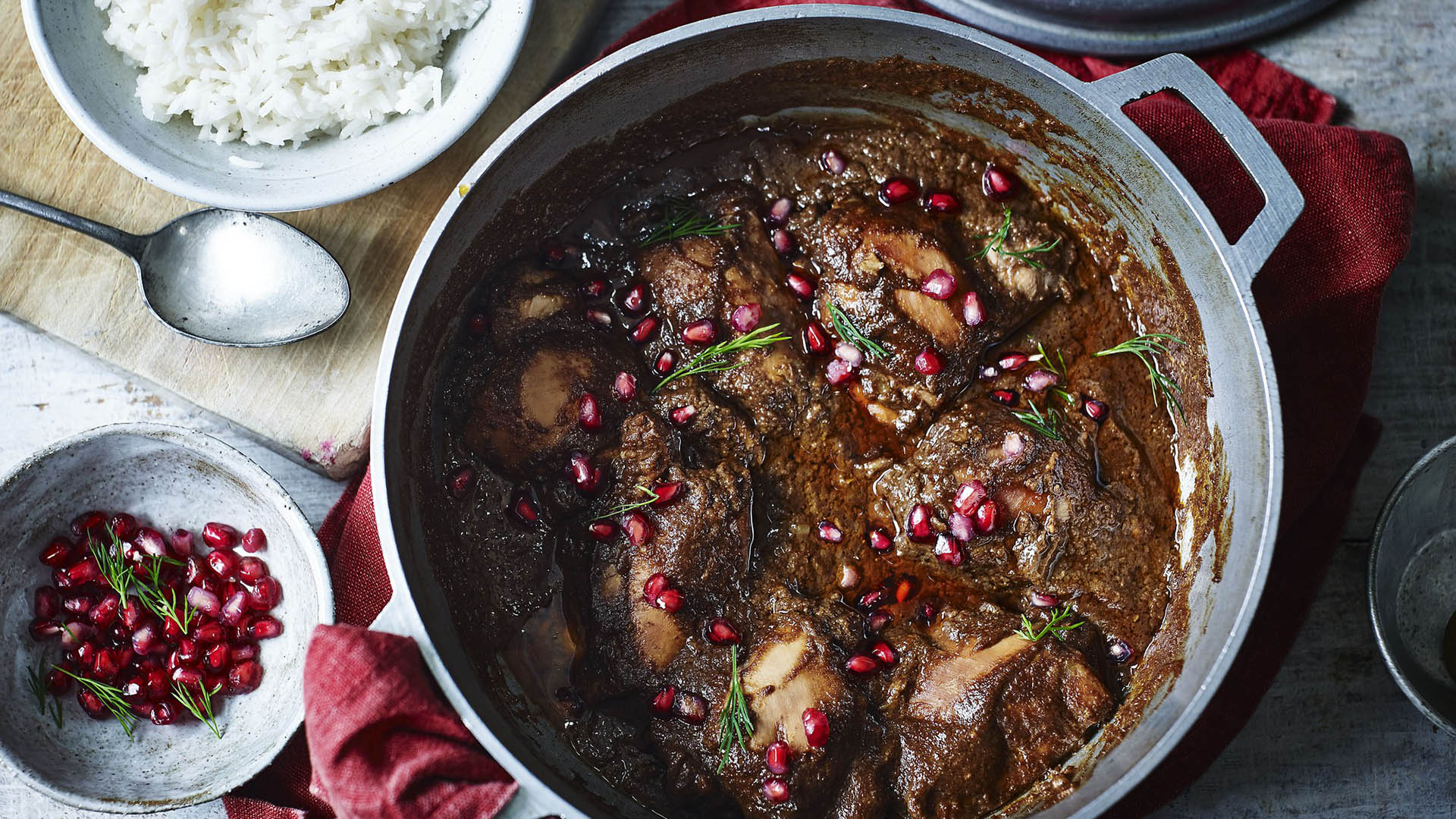
Introduction to Khoresh-e Fesenjan
What is Khoresh-e Fesenjan?
Khoresh-e Fesenjan, often simply referred to as Fesenjan, is a traditional Iranian stew made from ground walnuts, pomegranate paste, and meat. This dish is notable for its sweet and sour flavor, a result of the balance between the tangy pomegranate and the rich, nutty walnuts. Fesenjan is typically prepared with chicken or duck, though lamb or beef can also be used.
The Culinary Significance of Fesenjan
Fesenjan holds a special place in Iranian cuisine due to its luxurious ingredients and complex flavors. It is often reserved for special occasions and celebrations, symbolizing hospitality and the art of Persian cooking. The dish’s rich taste and texture reflect the sophistication and diversity of Iranian culinary traditions.
The History and Origins of Fesenjan
Historical Background
The origins of Fesenjan can be traced back to ancient Persia, where the use of walnuts and pomegranates in cooking was well established. These ingredients were valued for their flavor and nutritional benefits. Over time, Fesenjan evolved into a celebrated dish, enjoyed by royalty and commoners alike. Historical texts and Persian literature often reference Fesenjan, highlighting its enduring popularity.
Cultural Significance
In Persian culture, this food is more than just a meal; it is a representation of familial love, tradition, and the intricate art of Persian cuisine. It is a dish that brings people together, often served during festive occasions such as weddings, Nowruz (Persian New Year), and other significant celebrations. The effort and time required to prepare Fesenjan underscore the care and affection with which it is made and served.
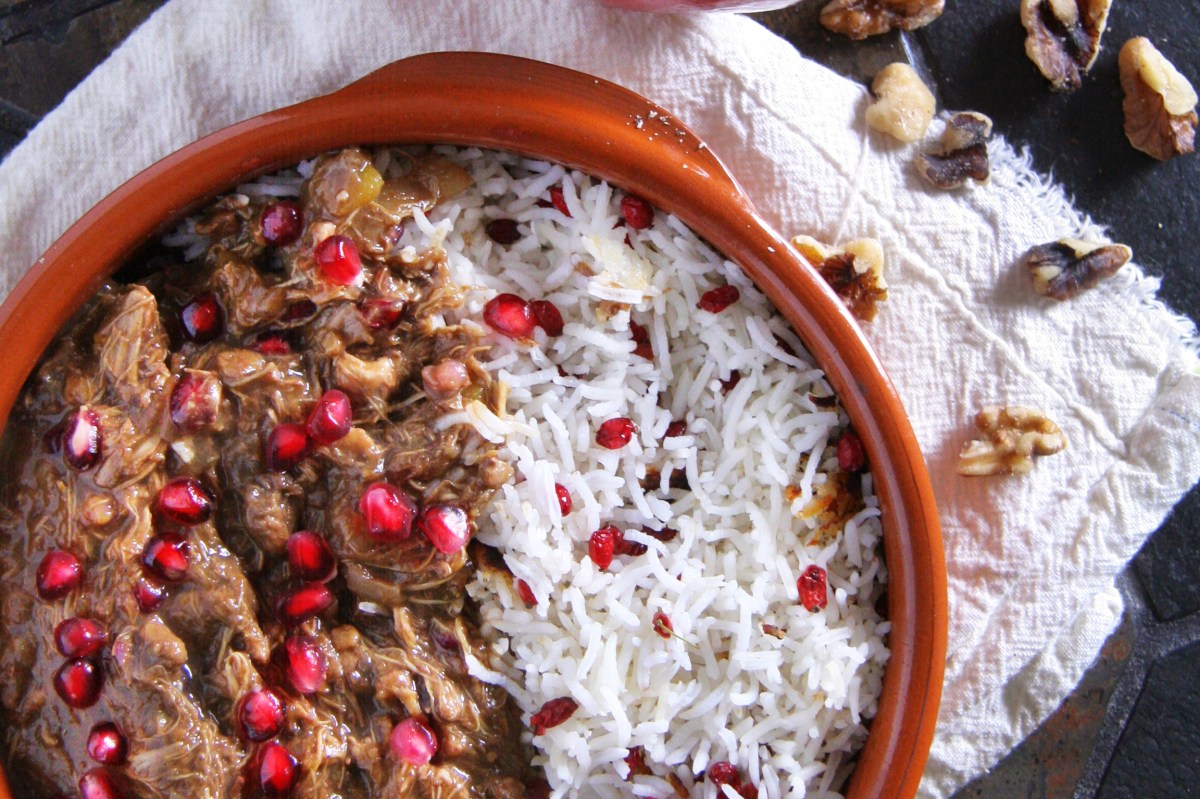
Ingredients of Fesenjan
Key Ingredients
- Walnuts: Ground walnuts form the base of the stew, providing a rich, creamy texture and nutty flavor.
- Pomegranate Paste: This ingredient gives Fesenjan its distinctive sweet and sour taste. Pomegranate paste can be found in Middle Eastern grocery stores or made at home.
- Meat: Chicken, duck, lamb, or beef are commonly used in Fesenjan. The meat is cooked until tender and absorbs the flavors of the sauce.
- Onions: Finely chopped onions are sautéed and serve as the foundation of the stew.
- Spices: Turmeric, salt, and pepper are the primary spices used, enhancing the natural flavors of the ingredients.
- Oil: Used for sautéing the onions and browning the meat, typically vegetable oil or olive oil.
- Water or Broth: Added to create the stew’s desired consistency.
Optional Ingredients
- Saffron: A small pinch of saffron can be added for extra depth of flavor and color.
- Sugar: Depending on the tartness of the pomegranate paste, a small amount of sugar can be added to balance the flavors.
Preparing Khoresh-e Fesenjan
Step-by-Step Recipe
1. Preparing the Walnuts
- Grind the Walnuts: Using a food processor, grind the walnuts until they are finely ground, resembling a coarse paste.
- Sauté the Walnuts: In a large pot, heat a small amount of oil and add the ground walnuts. Sauté over medium heat, stirring continuously to prevent burning. This step helps release the oils and flavors of the walnuts.
2. Preparing the Meat
- Sauté the Onions: In a separate pan, heat oil and sauté finely chopped onions until golden brown.
- Add the Meat: Add the meat to the pan and brown on all sides. Season with turmeric, salt, and pepper.
3. Combining Ingredients
- Combine Walnuts and Meat: Add the sautéed meat and onions to the pot with the walnuts.
- Add Pomegranate Paste: Stir in the pomegranate paste, ensuring it is well mixed with the walnuts and meat.
- Add Liquid: Pour in water or broth to cover the ingredients. Bring to a boil, then reduce the heat and let it simmer.
4. Simmering
- Simmer the Stew: Cover the pot and let the stew simmer over low heat for about 2-3 hours. Stir occasionally and add more water or broth if necessary to maintain the desired consistency.
- Adjust Seasoning: Taste the stew and adjust the seasoning with salt, pepper, and sugar if needed.
Serving Suggestions
- Plating: Serve Fesenjan in a large bowl, ensuring each serving has a good mix of meat and sauce.
- Accompaniments: Traditionally served with Persian steamed rice (chelow) or saffron rice. It can also be accompanied by fresh herbs (sabzi khordan), yogurt (mast), and pickles (torshi).
- Beverages: Pair the dish with traditional Iranian drinks such as doogh (a yogurt-based drink) or brewed saffron tea.

Nutritional Benefits of Fesenjan
Health Benefits of Ingredients
- Walnuts: Rich in healthy fats, protein, and antioxidants, walnuts contribute to heart health and provide essential nutrients.
- Pomegranate: High in vitamin C, antioxidants, and anti-inflammatory properties, pomegranate supports overall health and boosts the immune system.
- Meat: Provides high-quality protein, essential amino acids, and important vitamins and minerals such as iron and zinc.
Balanced Nutrition
This food offers a balanced meal, combining protein from the meat, healthy fats from the walnuts, and antioxidants from the pomegranate. When served with rice, it provides a good mix of macronutrients and essential vitamins and minerals, making it a wholesome and nutritious dish.
Cultural Significance of Fesenjan
Fesenjan in Persian Celebrations
This food is a staple at Persian celebrations and family gatherings. Its preparation is often a communal activity, with family members coming together to grind the walnuts, prepare the meat, and cook the stew. The dish’s rich, comforting flavors make it a favorite during Nowruz (Persian New Year), weddings, and other festive occasions, symbolizing prosperity and unity.
Symbolism and Traditions
In Persian culture, Fesenjan is more than just a stew; it is a symbol of home and tradition. Its preparation and sharing are seen as acts of love and hospitality, reflecting the cultural emphasis on family and community. The dish embodies the Persian philosophy of balance and harmony, combining a variety of ingredients to create a unified and delicious whole.
Modern Variations and Innovations
Contemporary Twists on Fesenjan
While traditional Fesenjan remains a favorite, modern chefs and home cooks have introduced various twists to the classic recipe. Some popular variations include:
- Vegetarian Fesenjan: Substituting meat with tofu or additional vegetables such as eggplant or mushrooms to cater to vegetarian diets.
- Fesenjan with Quinoa: Serving the stew with quinoa instead of rice for a gluten-free option.
- Fusion Dishes: Incorporating elements from other cuisines, such as adding Mediterranean spices or serving with couscous.
Fesenjan in International Cuisine
As Iranian cuisine gains popularity worldwide, Fesenjan has found its way onto the menus of international restaurants. Chefs around the globe are experimenting with this dish, introducing it to new audiences and adapting it to suit diverse palates. This global interest not only highlights the universal appeal of Fesenjan but also promotes a greater understanding and appreciation of Iranian culture.
How to Enjoy Fesenjan at Home
Tips for Home Cooks
- Quality Ingredients: Use fresh, high-quality ingredients, including authentic pomegranate paste and fresh walnuts, to achieve the best results.
- Patience is Key: Take your time with each step, especially when sautéing the walnuts and simmering the stew, to ensure perfect texture and flavor.
- Balance Flavors: Taste and adjust the seasoning and balance between sweet and sour to achieve the desired harmony of flavors.
Where to Buy Ingredients
Specialty Iranian or Middle Eastern grocery stores are the best places to find authentic ingredients for Fesenjan. Online retailers also offer a variety of products, including pomegranate paste, fresh walnuts, and high-quality spices.

Conclusion
This food is a culinary masterpiece that exemplifies the richness of Iranian cuisine. Its unique combination of ground walnuts, tangy pomegranate paste, and tender meat makes it a dish that delights the senses and nourishes the soul. Whether enjoyed at a festive gathering or a cozy family dinner, Fesenjan embodies the warmth, hospitality, and cultural heritage of Persia.
By exploring the history, ingredients, preparation, and cultural significance of Fesenjan, we gain a deeper appreciation for this iconic dish and the rich culinary traditions of Iran. Whether you’re an experienced cook or a culinary enthusiast, making Fesenjan at home is a rewarding experience that brings the flavors of Iran to your table.
The Joy of Sharing Fesenjan
Community and Family Bonds
Preparing and sharing Fesenjan is a time-honored tradition that strengthens family bonds and fosters a sense of community. The process of making the dish is often a collaborative effort, with each family member contributing to the preparation. This communal activity not only makes the cooking process more enjoyable but also reinforces the values of cooperation and togetherness that are central to Persian culture.
Preserving Tradition
In an ever-changing world, Fesenjan remains a steadfast reminder of Iran’s rich culinary heritage. By passing down the recipe from generation to generation, families preserve their cultural identity and maintain a connection to their roots. The dish serves as a delicious bridge between the past and the present, honoring the traditions of ancestors while adapting to modern tastes and preferences.
The Global Appeal of Fesenjan
Introducing Iranian Cuisine to the World
As globalization brings cultures closer together, this food is becoming increasingly popular beyond the borders of Iran. Food enthusiasts and chefs from around the world are discovering the unique flavors and textures of this Persian stew, introducing it to new audiences and incorporating it into their culinary repertoires. This global interest not only highlights the universal appeal of Fesenjan but also promotes a greater understanding and appreciation of Iranian culture.
Culinary Exchange and Innovation
The international popularity of Fesenjan has also led to exciting culinary innovations. Chefs are experimenting with new ingredients and techniques, creating fusion dishes that blend Persian flavors with elements from other cuisines. This cross-cultural exchange enriches the culinary landscape, inspiring creativity and broadening the horizons of food lovers everywhere.
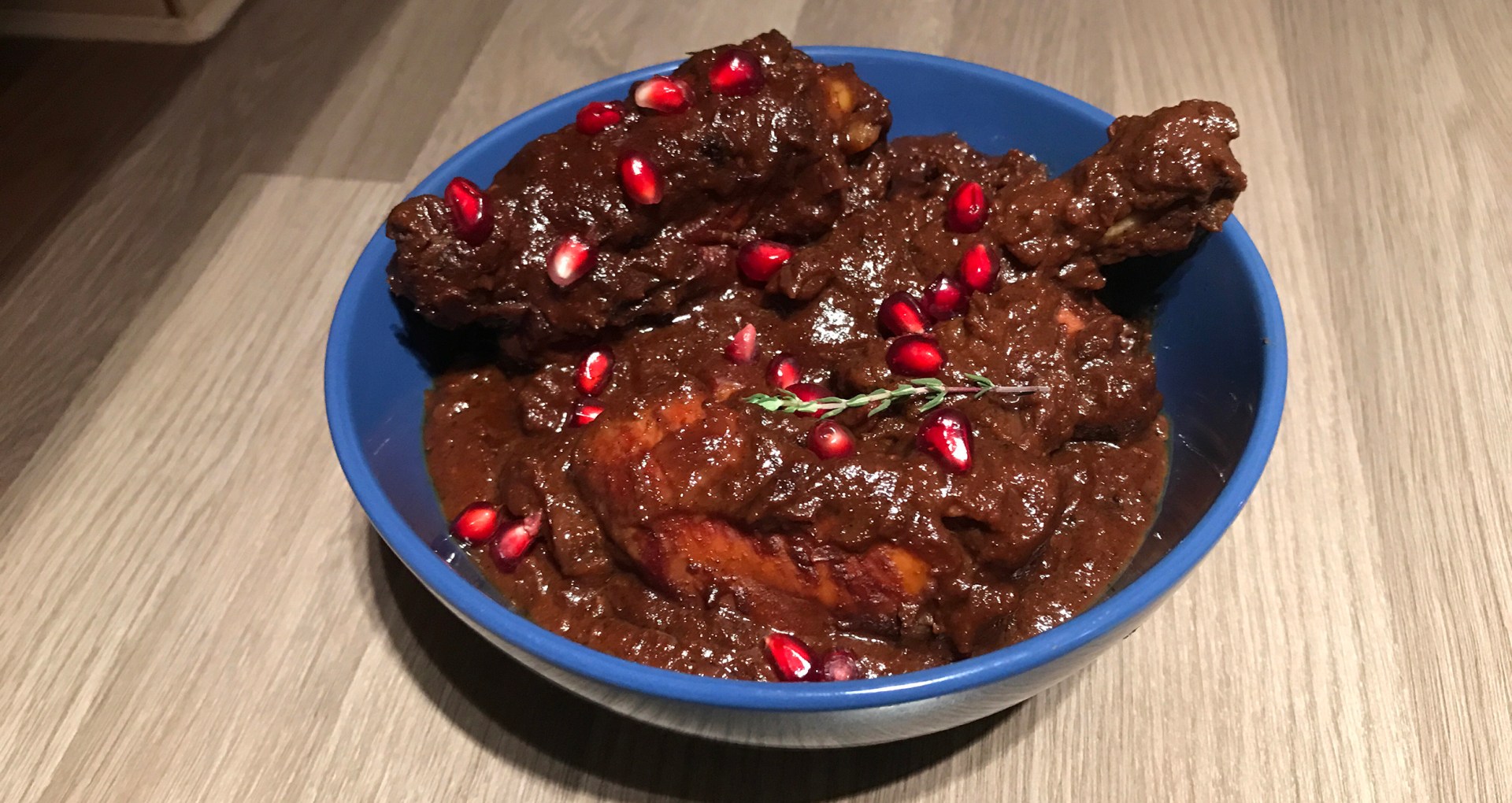
Conclusion
This food is more than just a dish; it is a celebration of Iranian culinary artistry, cultural heritage, and the timeless joy of sharing good food with loved ones. Its rich flavors, vibrant colors, and comforting qualities make it a beloved staple in Persian households and a rising star in global cuisine.
By exploring the history, ingredients, preparation, and cultural significance of Fesenjan, we gain a deeper appreciation for this iconic stew and the rich traditions of Iranian cooking. Whether you are a seasoned chef or a curious food lover, making Fesenjan at home is a rewarding journey that brings the essence of Persia to your kitchen and your table.
Experience the magic of Fesenjan and discover the timeless appeal of Iranian cuisine. Invite your friends and family to join you in preparing and enjoying this delicious stew and celebrate the rich flavors and traditions that make Persian food truly special.

